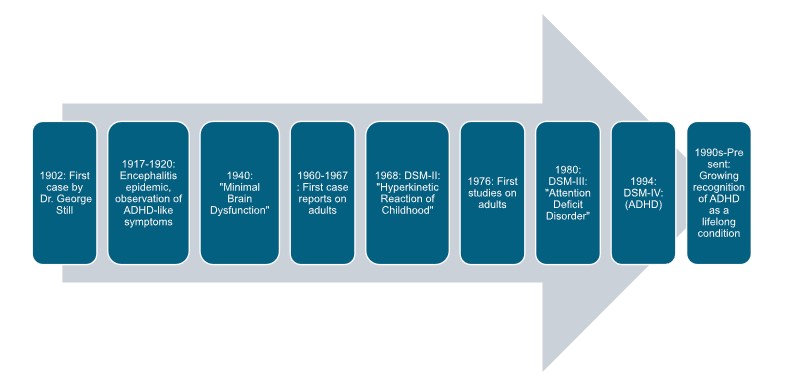Do you ever feel like your brain has a mind of its own? Do you struggle with focus, get easily distracted, or find yourself constantly on the go? If so, you’re not alone. Millions of adults grapple with these challenges every day, often unaware that they might be living with ADHD.
A Look Back in Time
Believe it or not, ADHD isn’t a new discovery. It was first described way back in the 1700s by the philosopher John Locke, who observed students struggling to concentrate, no matter how hard they tried. But it wasn’t until the early 1900s that a doctor named George Still provided a more formal description of the condition. Still recognized that children with ADHD were often restless, impulsive, and had trouble paying attention.
In the aftermath of World War I, a fascinating connection was made. Children who had recovered from encephalitis (a brain inflammation) exhibited similar behaviors to those described by Still. This was a major clue, suggesting that ADHD could have a biological basis.
A Winding Path to Understanding
The path to understanding ADHD has been winding and complex. Early on, it was thought that the condition disappeared in adulthood. However, research in the 1960s started to challenge this notion, paving the way for a broader recognition of adult ADHD.
Throughout the 20th century, the name and diagnostic criteria for ADHD evolved multiple times. It was variously called “Minimal Brain Dysfunction,” “Hyperkinetic Reaction of Childhood,” and finally, “Attention Deficit Hyperactivity Disorder.” These changes reflected a growing awareness of the different ways ADHD can present in individuals.
ADHD Today: A Lifelong Condition
Today, we know that ADHD is not just a childhood disorder. It often persists into adulthood, impacting work, relationships, and daily life. There’s also a greater understanding of the different types of ADHD – primarily inattentive, primarily hyperactive-impulsive, and combined – each with its own unique challenges and strengths (Figure-1).

What Does This Mean for You?
If you’re an adult struggling with attention problems, forgetfulness, or a feeling of constant mental restlessness, it’s important to remember that you’re not alone. ADHD is a common condition, and it’s not a sign of weakness or a character flaw. It’s a neurobiological difference that can be managed effectively with the right tools and support.
Treatment Options: Beyond Stimulants
While stimulant medications are often the first-line treatment for ADHD, they aren’t the only option. If stimulants aren’t a good fit for you, or if you experience side effects, non-stimulant medications may be worth considering. These medications work by interacting with different brain chemicals that play a role in attention, focus, and impulse control. For example, some non-stimulant options work by increasing the amount of norepinephrine in the brain, a chemical messenger that helps you stay focused and attentive. This can also help with impulse control and hyperactivity. Other non-stimulant medications target different brain chemicals, such as dopamine, to improve motivation and focus. Some medications even come in both short-acting and long-acting forms, providing flexibility in treatment and addressing issues like sleep difficulties that can accompany ADHD.
It’s important to note that non-stimulant medications may take a bit longer to start working than stimulants. However, they can be a valuable tool in your ADHD management toolkit and they may cover the entire day.
If you suspect you might have ADHD, I encourage you to reach out to a healthcare professional. They can help you understand your symptoms, assess whether ADHD is a good fit, and develop a personalized treatment plan to help you thrive.
Remember: ADHD is not a life sentence. It’s a journey of understanding, growth, and resilience.
*Adapted from my thesis: Selek, S (2007) Evaluation of oxidative metabolism in adult attention deficit/hyperactivity disorder. [Dissertation, G.Antep University. Thesis number: 195280]






1 Comment
Jessica W.
What a thorough explanation. Thank you for sharing!